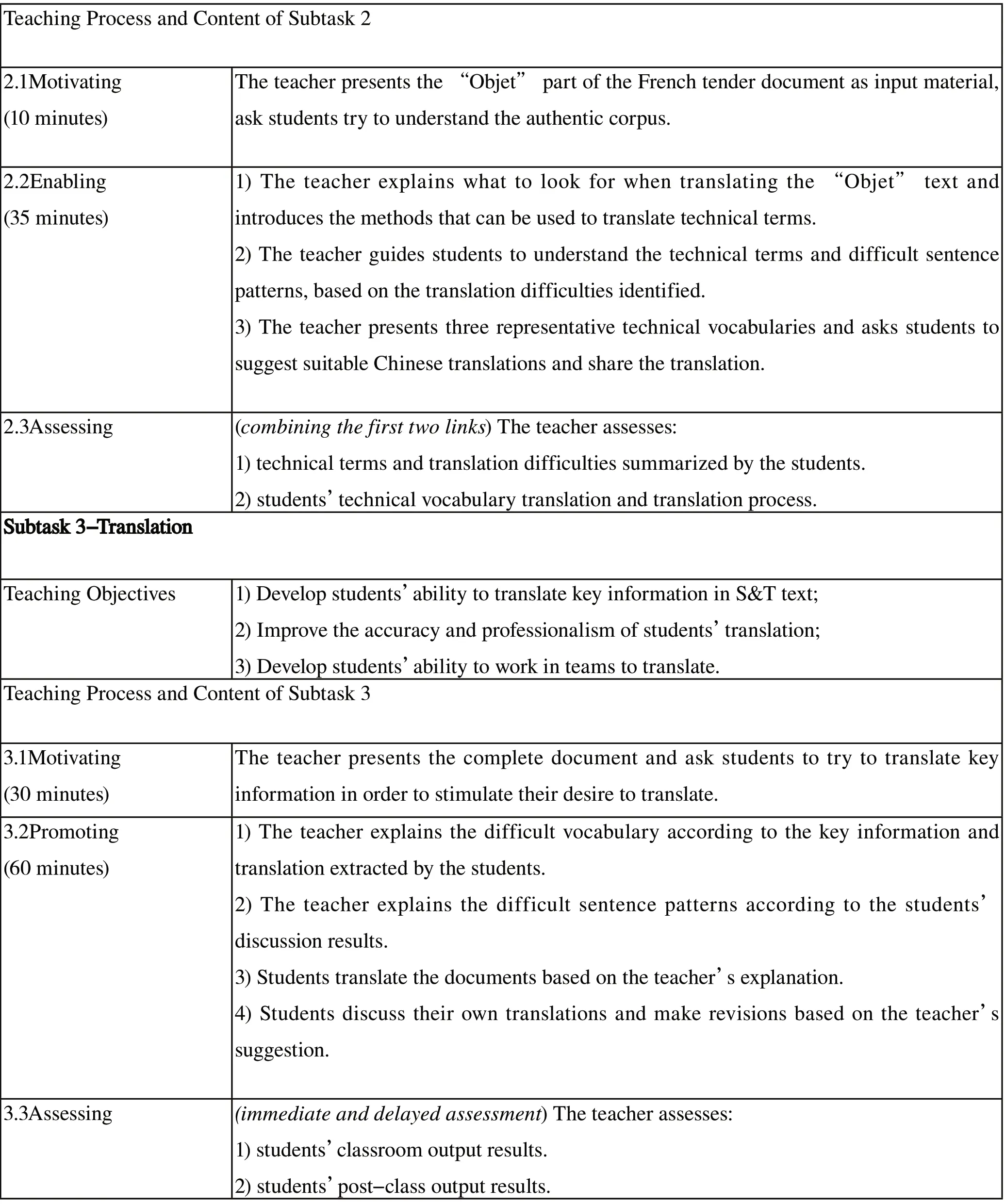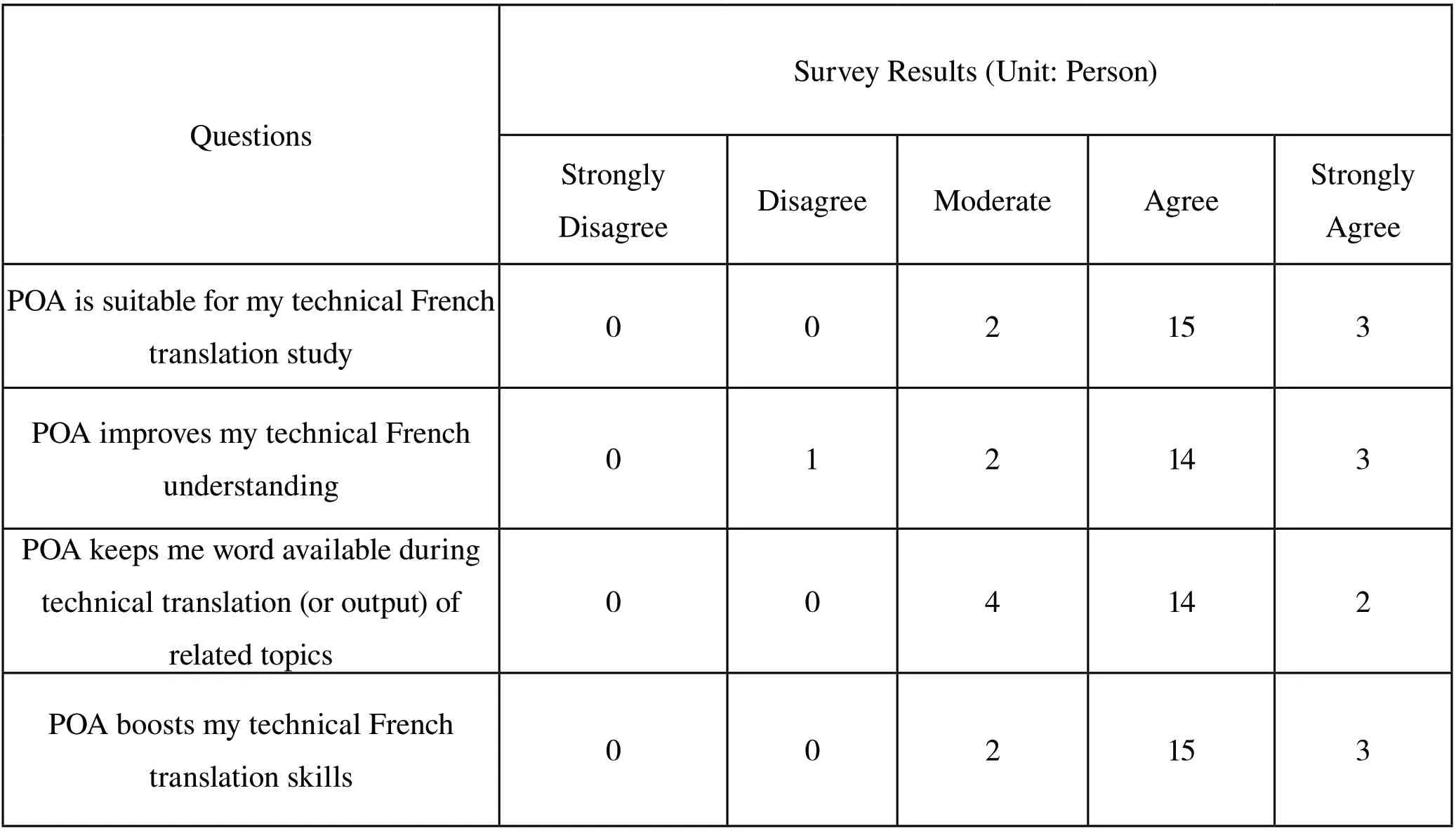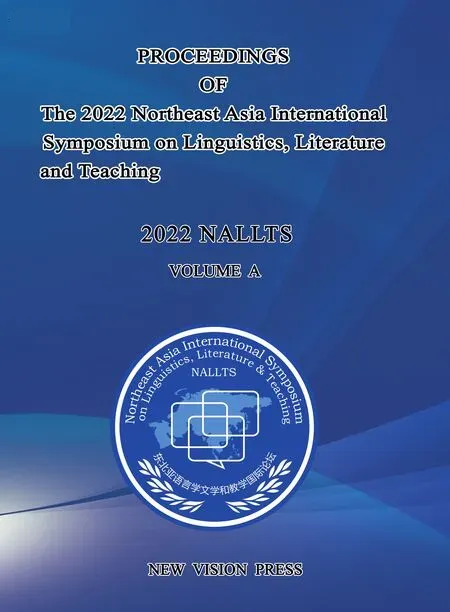Teaching Practice and Research of Scientific and Technical French Translation Based on Production-Oriented Approach
Minghao Chen
School of Foreign Languages, Wuhan University of Technology, Wuhan, China
Email : chenmh@vip.163.com
Xuemei Yu
Academic Affairs Office, Zhixing College of Hubei University, Wuhan, China
Email: 42684273@qq.com
[Abstract] “The Production-Oriented Approach (POA)”is a foreign language teaching theory with Chinese characteristics. The aim of this study is to explore the feasibility of applying POA to the teaching of Scientific and Technical (S&T) French Translation through teaching practice and the use of questionnaires and other methods. It was found that POA teaching can help students improve their learning ability to acquire subject-related knowledge, enhance self-directed learning, strengthen teamwork and improve the quality of their S&T translation output. However, in the application of POA in the teaching of S&T translation, it is necessary to consider the diversity of students’language level and translation ability, and to make targeted adjustments to the teaching content and methods in terms of the effective combination of the three links of “Motivating-Enabling-Assessing”, in order to improve the learning motivation of students at all levels.
[Keywords]Production oriented Approach; scientific and technical translation teaching; teaching effects; output capacity
Introduction
From the perspective of the exponential development of science and technology, scientific and technical (S&T) translations are becoming more and more important and place greater demands on translators (Li, 2021, p. 210). S&T translation courses are an important part of the training system of translation talents, research into it can improve the teaching quality and effect and promote teachers to innovate the teaching concepts and methods. French is one of the most widely used languages in science and technology other than English, and most of the relevant research is focused on the teaching of S&T English, with relatively little research on the teaching of S&T French, which focus more on the following topics: (1) the S&T French translation practice (Shen, 2007, p. 214; Li, 2012, p. 5); (2) the application of applied or mixed teaching in the teaching of S&T French (Ding, 2014, p. 31; Wang, 2021, p. 61); (3) the analyze of teaching strategies for S&T French with a specific group of students from a specific country (Boyon, 2011, p. 255; Belhocine, 2014, p. 42). Overall, there is a dearth of research on the teaching of S&T French translation. In the context of the new era, in order to establish a scientific teaching system for French translation talents, so as to train translation talents required by the times, it is urgent and necessary to deepen the research on the theory and practice of S&T French translation teaching.
“Output Oriented Approach (POA)”is a teaching theory created by Chinese scholars for Intermediate and senior foreign language learners. This theory attaches importance to “production” and “output”. “Production” emphasizes both the production process (producing) and the production result (product). Therefore, “Production” includes translation and interpretation in addition to speaking, reading and writing referred to “output” (Wen, 2015, p. 547). The teaching concepts advocated by POA include “Learning-centered Principle”, “Learningusing Integrated Principle” and “Whole-person Education Principle”. POA has been widely practiced in English teaching in China and achieved some success, but there is a lack of time and research on the application of POA in French teaching. Therefore, the author attempts to introduce the POA teaching concept into the practice of S&T French translation teaching, so as to innovate teaching methods, improve the students’“output ability”, and achieve the “Integration of Learning and Using”.
Teaching Experiment
The Purpose of the Experiment
Although the course content of S&T French Translation is constantly updated in the face of social and market demand, the teaching method still remains on the traditional concept of “Teaching-centered, knowledge inputoriented”. Under this traditional teaching mode, students’S&T translation output ability is not satisfactory, especially for highly specialized text translation, students report that it is difficult to understand and re-express the text. Therefore, this teaching experiment will test the applicability of POA in the course of S&T French translation, and find out the possible problems in the implementation of POA, so as to gain experience in the follow-up teaching reform.
Teaching Objects
The target group for this teaching experiment was 20 students, 3 male and 17 female, in the fourth year of French major at a university in Hubei Province of China. After three years of study, students’French listening, speaking, reading and writing skills have basically reached the B2 standard stipulated in CEFR, with some students reaching the C1 level. In addition, the university’s French major training program offers “S&T French Reading I & II” in the first and second semesters of the third year respectively, so students have a good understanding of S&T French vocabulary and syntax, and have a certain basis for reading S&T French texts before they enter the fourth year to study S&T French translation.
Teaching Plan
Based on the POA theory, this experimental teaching plan is designed to include three links of “Motivating-Enabling-Assessing”, which form a complete cycle, and can be arranged in several ways according to actual teaching needs. On the basis of this concept, the author has designed a unit of S&T translation teaching plan with the “construction tender” document translation as the teaching theme. The teaching time is 4 hours, and the output task is the translation of French tender documents, which requires students to be able to translate the technical vocabulary and sentences in the tender documents accurately and smoothly. POA requires that the output tasks can present realistic communication scenarios that may be encountered in future study and work to students. Therefore, the output tasks of this unit will be based on authentic corpus. In order to achieve the output objectives set for this unit, the author has designed three subtasks: subtask 1 is “discussion”, which allows students to discover the vocabulary, syntax, text and other characteristics of the tender documents through discussion, and lay the foundation for the achieving functional equivalence of the text in the translation process; subtask 2 is “comprehension”, students understand the technical terminology in the text based on the first stage task results and subject-related knowledge; subtask 3 is “translation”, in which students translate a French technical text to Chinese after understanding the technical terminology and texts. Each subtask includes three components of “Motivating-Enabling-Assessing”, as shown in Table 1:

Table 1: Subtask Teaching Process

Teaching Process and Content of Subtask 2 2.1Motivating (10 minutes)The teacher presents the “Objet” part of the French tender document as input material, ask students try to understand the authentic corpus. 2.2Enabling (35 minutes)1) The teacher explains what to look for when translating the “Objet” text and introduces the methods that can be used to translate technical terms.2) The teacher guides students to understand the technical terms and difficult sentence patterns, based on the translation difficulties identified.3) The teacher presents three representative technical vocabularies and asks students to suggest suitable Chinese translations and share the translation.2.3Assessing (combining the first two links) The teacher assesses:1) technical terms and translation difficulties summarized by the students.2) students’technical vocabulary translation and translation process.Subtask 3-Translation Teaching Objectives 1) Develop students’ability to translate key information in S&T text;2) Improve the accuracy and professionalism of students’translation;3) Develop students’ability to work in teams to translate.Teaching Process and Content of Subtask 3 The teacher presents the complete document and ask students to try to translate key information in order to stimulate their desire to translate.3.2Promoting (60 minutes)3.1Motivating (30 minutes)1) The teacher explains the difficult vocabulary according to the key information and translation extracted by the students.2) The teacher explains the difficult sentence patterns according to the students’ discussion results.3) Students translate the documents based on the teacher’s explanation.4) Students discuss their own translations and make revisions based on the teacher’s suggestion.3.3Assessing (immediate and delayed assessment) The teacher assesses:1) students’classroom output results.2) students’post-class output results.
Teaching Process
The comprehensive implementation strategy of POA is to cover all aspects of teaching (Motivating-Enabling-Assessing) in a loop so that teachers can put the teaching concept into practice (Wen Qiufang, 2017). The author takes subtask 1 as an example to provide a detailed description of the three teaching aspects.
Motivating
In contrast to traditional teaching methods which places “warm-up” at the beginning of new unit, POA advocates placing the “Motivating” at the beginning (Wen, 2015, p. 247). The motivation consists of three steps: (1) the teacher presents the scenario; (2) the students try to output; (3) the teacher explains the teaching objectives and output tasks. Therefore, in the “Motivating” part, the input material presented by the author to the students is an introduction to tender in French, so that students can experience the tender scenario and understand the definition and basic procedures of tender. The material include texts on construction projects that students have already been exposed before the unit, such as “ma?tre d’ouvrage (owner)”, “travaux publics (public works)”, as well as “soumissionnaire (bidder)”, “appel d’offres (bidding)”, and other professional vocabulary in the field of bidding that students have not been exposed to yet. The input materials motivate students to think about and understand the meaning of tender and the characteristics of tender documents, so that students are aware of their own lack of output ability, and thus enter the state of “desire” in wanting to know how to complete the French translation.
Enabling
“Enabling” includes three main components: (1) the teacher describes output tasks; (2) Students engage in selective learning and the teacher guides and checks; 3) Students practice and output, the teacher guides and checks (Wen Qiufang, 2015). In this process, the teacher assumes the role of “scaffold”, which enables the students to select the required content from the input materials in order to complete the output task (Cao Qiaozhen, 2017). In the “Enabling” part of subtask 1, the author designed three contents: firstly, the teacher guides the students to discuss the input materials in groups, and sort out the technical terms and difficult sentence patterns. The teacher gives heuristic explanations in relation to the tender scenario; secondly, the teacher analyzes the technical terms and other language features in the French documents based on the input documents and the students’discussion results, such as the extensive use of impersonal sentence pattern, the extensive use of verb infinitive structures, etc., and guides students to analyze the formatting, technical vocabulary and sentence patterns that they need to pay attention to in translation; finally, the teacher presents three representative technical vocabulary, such as “création de lots (division of tenders)”, “choix du prestataire (choice of suppliers)”, and guides students to suggest relevant Chinese translations through technical vocabulary search, image search and other methods. The teacher and students discuss and propose revisions together to select the best translation.
Assessing
The “Assessing” in POA can be divided into immediate assessment and delayed assessment. Immediate assessment means that the teacher assesses the students’learning effect during the practice of output tasks in the process of “Enabling”. Delayed assessment refers to students practicing outside of class according to the teacher’s requirements and submitting the results to the teacher for assessment (Wen, 2015, p. 247). The “Assessing” in subtask 1 of this course is an immediate assessment, which aims to help teachers adjust the teaching rhythm and control the teaching progress in real time, and to help students understand their learning outcomes and improve their output quality. Therefore, the “Assessing” of the subtask of this course mainly includes: (1) After the students discuss the input materials, they will discuss the definition and procedures of the tender to come to the discussion results, then teacher and students will jointly assess the relevant results. (2) Students discuss the understanding of the representative technical vocabulary presented by the teacher and determine the relevant translation, teacher and students jointly assess the professional vocabulary translation and translation process. The “Assessing” of subtask 1 combines with the “Motivating” and “Enabling”, and is based on the mode of joint discussion and suggestion between teacher and students. In addition, the immediate assessment of subtasks will be combined with the delayed assessment of the course. The teacher assigns a French tender document to the students after class, ask them to translate it and send it to him in the form of text for assessing.
Experiment feedback
In order to understand students’feedback on this teaching experiment, the author collected data through anonymous questionnaires at the end of the course. A total of 20 questionnaires were distributed and 20 valid questionnaires were returned, the results of which are shown in Table 2.

Table 2: Student Questionnaire Results
The survey results show that 90% of students agree that POA is suitable for their technical French translation study, and 90% of students agree that POA can effectively promote the improvement of their technical French translation ability. It can be seen that the vast majority of students can accept the application of the POA concept in the teaching of technical French translation. In addition, students also reflected in the questionnaire survey that there are two main difficulties encountered in the process of S&T translation: (1) the lack of subject-related knowledge reserve for a particular technical subject. (2) insufficient technical vocabulary which affects comprehension and translation. The aim of teaching S&T French translation is to improve students’comprehension of S&T texts and their translation skills, so practical translation training and assessment are more important than theoretical language lectures. POA emphasizes on“Learning-centered Principle”and aims to improve students’actual“output”ability. Therefore, the application of this teaching concept in the teaching of S&T French translation can help teachers effectively combine the input materials that motivate understanding with the output tasks which test translation ability.
Conclusion
This study explores the feasibility of POA in S&T French translation teaching through teaching practice and questionnaires. It was found that on the basis of teachers’reasonable setting of teaching content, the vast majority of students recognized the applicability of POA in the teaching of S&T French translation, and recognized that the teaching concept can effectively help them provide S&T French translation ability. At the same time, the application of POA in the teaching of S&T French translation also helps students to improve their autonomy in acquiring subjectrelated knowledge, to understand the importance of teamwork in translation practice, and to improve the quality of S&T translation output. However, two problems have been identified in this teaching practice. Firstly, although POA is a teaching method for intermediate and advanced foreign language learners and most students have a level of about B2, considering the difficulty of S&T French translation course itself, there are still students with poor foundations who found it difficult. Therefore, teachers could try to set differentiated output tasks for different students to improve the learning enthusiasm of students at all levels. Secondly, there are currently no published materials suitable for teaching translation in S&T French, and there is a lack of translation teaching materials based on the POA concept for reference. As a result, teachers need to spend a lot of time searching for and selecting input materials that can be used, and the extraordinary complexity of the course preparation process also places high demands on teachers.
 Proceedings of Northeast Asia International Symposium on Linguistics,Literature and Teaching2022年0期
Proceedings of Northeast Asia International Symposium on Linguistics,Literature and Teaching2022年0期
- Proceedings of Northeast Asia International Symposium on Linguistics,Literature and Teaching的其它文章
- Research on Teaching Model of Integrating Critical Thinking Skills into College Public English Writing
- The Application Advantages and Subsequent Problems of Blended Teaching Mode in University English Course: A Reflection Based upon the Status Quo of Short Hours and Large Classes
- Effective Approaches to Teaching Listening Among First-year EFL Students in Chinese Universities
- A Study of Toni Morrison’s God Help the Child from Postmodernism
- On Lu Xun’s Literature Translation from the Perspective of Translation as Adaptation and Selection
- On Translation of Traditional Chinese Tuina Text from the Perspective of Skopos Theory
